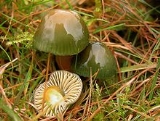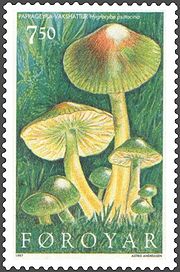
Hygrocybe psittacina
Encyclopedia
Hygrocybe psittacina, commonly known as the Parrot Toadstool or Parrot Waxcap, is a colourful member of the genus Hygrocybe
, the waxcaps, found across Northern Europe. Originally described as Hygrophorus psittacinus, there have been at least two subspecies described, H. psittacina var. psittacina and H. psittacina var. perplexa, which was initially described as a separate species H. perplexa.
The bright green colour of this fungus
is not due to chlorophyll
; fungi do not possess this chemical.
 The Parrot Toadstool is a small mushroom, with a convex to umbonate cap
The Parrot Toadstool is a small mushroom, with a convex to umbonate cap
1–3 centimetres (⅓–1 in) in diameter, which is green when young and later yellowish or even pinkish tinged. The 2–4 cm stipe
is green to greenish yellow. The broad adnate gills are greenish with yellow edges and spore print white. The green colouring persists at the stem apex even in old specimens.
Its odour and taste is not distinctive. There are no know chemical tests.
It fruits late summer to autumn (September to November)
, Iceland
, Greenland
, the Americas, South Africa and Japan, being found in late summer and autumn. In Europe it is apparently in decline due to the degradation of habitats. Early Australian records of this form have been found to be the similar green toadstools Hygrocybe graminicolor or H. stevensoniae on reexamination.
H. psittacina var. perplexa has been recorded in Western Europe, the Americas and Japan as well as one Australian record in Eastern Victoria
.
It is found in small trooping groups amongst short mown or cropped grass.
Hygrocybe
Hygrocybe is a genus of agarics in the family Hygrophoraceae. Called "waxcaps" in English , basidiocarps are often brightly coloured and have waxy to slimy caps, white spores, and smooth, ringless stems...
, the waxcaps, found across Northern Europe. Originally described as Hygrophorus psittacinus, there have been at least two subspecies described, H. psittacina var. psittacina and H. psittacina var. perplexa, which was initially described as a separate species H. perplexa.
The bright green colour of this fungus
Fungus
A fungus is a member of a large group of eukaryotic organisms that includes microorganisms such as yeasts and molds , as well as the more familiar mushrooms. These organisms are classified as a kingdom, Fungi, which is separate from plants, animals, and bacteria...
is not due to chlorophyll
Chlorophyll
Chlorophyll is a green pigment found in almost all plants, algae, and cyanobacteria. Its name is derived from the Greek words χλωρος, chloros and φύλλον, phyllon . Chlorophyll is an extremely important biomolecule, critical in photosynthesis, which allows plants to obtain energy from light...
; fungi do not possess this chemical.
Description

Pileus (mycology)
The pileus is the technical name for the cap, or cap-like part, of a basidiocarp or ascocarp that supports a spore-bearing surface, the hymenium. The hymenium may consist of lamellae, tubes, or teeth, on the underside of the pileus...
1–3 centimetres (⅓–1 in) in diameter, which is green when young and later yellowish or even pinkish tinged. The 2–4 cm stipe
Stipe (mycology)
thumb|150px|right|Diagram of a [[basidiomycete]] stipe with an [[annulus |annulus]] and [[volva |volva]]In mycology a stipe refers to the stem or stalk-like feature supporting the cap of a mushroom. Like all tissues of the mushroom other than the hymenium, the stipe is composed of sterile hyphal...
is green to greenish yellow. The broad adnate gills are greenish with yellow edges and spore print white. The green colouring persists at the stem apex even in old specimens.
Its odour and taste is not distinctive. There are no know chemical tests.
It fruits late summer to autumn (September to November)
Distribution and habitat
H. psittacina var. psittacina is widely distributed in grasslands in Western EuropeWestern Europe
Western Europe is a loose term for the collection of countries in the western most region of the European continents, though this definition is context-dependent and carries cultural and political connotations. One definition describes Western Europe as a geographic entity—the region lying in the...
, Iceland
Iceland
Iceland , described as the Republic of Iceland, is a Nordic and European island country in the North Atlantic Ocean, on the Mid-Atlantic Ridge. Iceland also refers to the main island of the country, which contains almost all the population and almost all the land area. The country has a population...
, Greenland
Greenland
Greenland is an autonomous country within the Kingdom of Denmark, located between the Arctic and Atlantic Oceans, east of the Canadian Arctic Archipelago. Though physiographically a part of the continent of North America, Greenland has been politically and culturally associated with Europe for...
, the Americas, South Africa and Japan, being found in late summer and autumn. In Europe it is apparently in decline due to the degradation of habitats. Early Australian records of this form have been found to be the similar green toadstools Hygrocybe graminicolor or H. stevensoniae on reexamination.
H. psittacina var. perplexa has been recorded in Western Europe, the Americas and Japan as well as one Australian record in Eastern Victoria
Victoria (Australia)
Victoria is the second most populous state in Australia. Geographically the smallest mainland state, Victoria is bordered by New South Wales, South Australia, and Tasmania on Boundary Islet to the north, west and south respectively....
.
It is found in small trooping groups amongst short mown or cropped grass.

